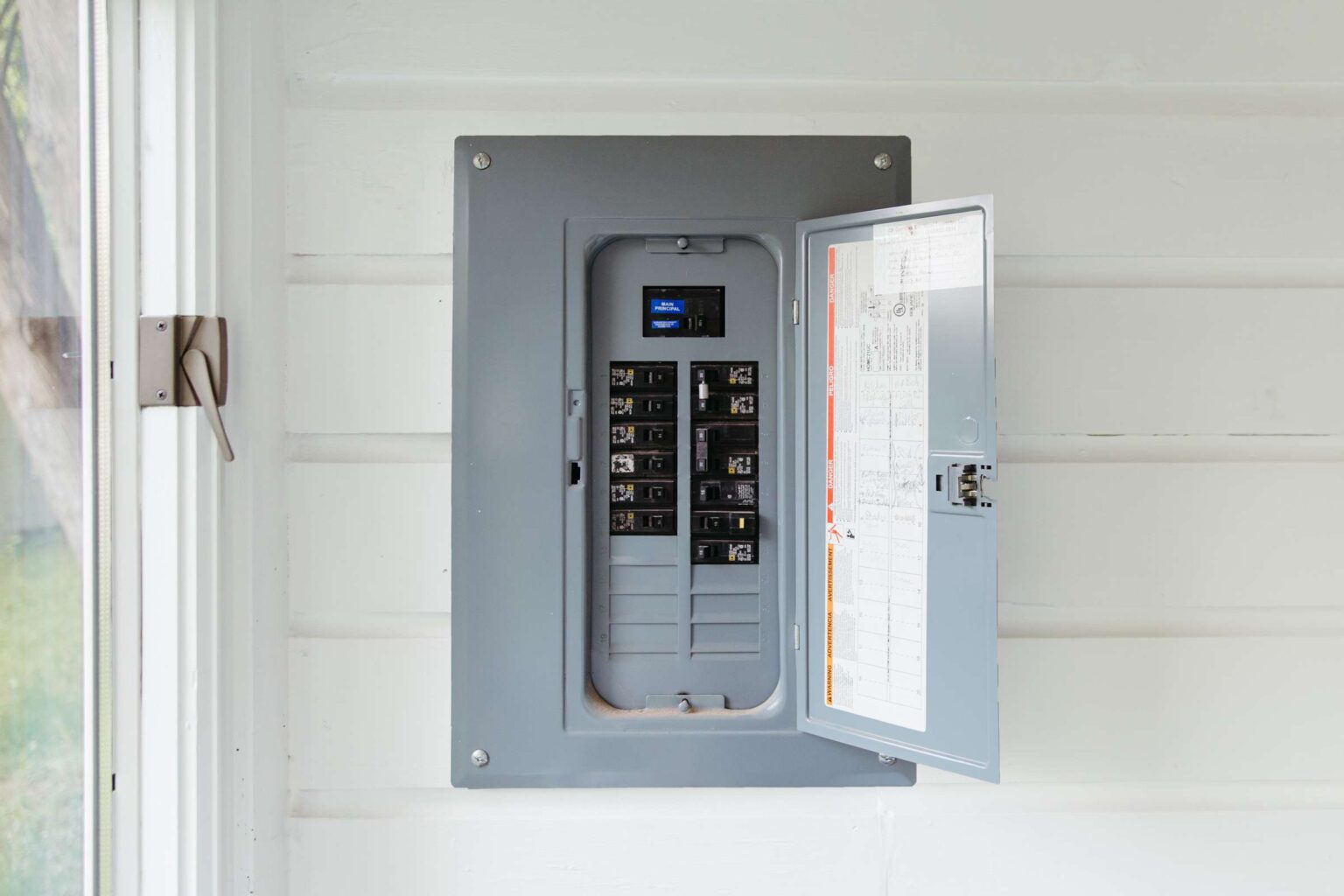All homes have a main electrical service panel, a circuit breaker panel, or a fuse box in older homes. This panel receives power from the local electrical utility and sends it to the various branch circuits in the house. Turning off the power from your home’s electrical service panel is the safest way to shut down a circuit before rewiring or repairing it.
The service panel is also where you can reset a tripped circuit breaker and turn off power to your entire home and all of its circuits using the main circuit breaker.
Watch Now: Everything You Need to Know About Your Breaker Box
Find the Service Panel
The Spruce / Kevin Norris
You’ll need to find your home’s electrical service panel before you can shut off the power or reset tripped breakers. This is typically a large gray metal box attached to one of the walls in or around your home. It opens up to reveal two columns of switches, which are the circuit breakers.
The service panel is usually found in out-of-the-way rooms and areas in or around the house. Some possible locations are the garage (or the hallway leading to the garage), basement, utility room, pantry, or covered area of your yard.
Older homes built before 1965 have circuits wired with fuses instead of breakers in an electrical service panel. Remove and replace fuses in fuse boxes to turn the power off and on. These are usually smaller white boxes that sit horizontally instead of vertically and are generally located on an exterior wall of the home.
Test and Turn Off the Breaker Box
How to Turn Off Power to Your House
The Spruce / Kevin Norris
Turning off the main breaker and stopping power to the entire house is sometimes needed in an emergency if you’re struggling to determine which circuit needs repairing when installing a new appliance, such as an air conditioner, or when completing major rewiring or renovation projects.
Before opening the door to your electrical service panel, check to ensure the floor around you is dry. Once the door is open, you should see two columns of labeled circuit breakers, with a larger breaker switch either above or below. While individual circuit breakers will be labeled as 15 or 20 amps—the standard levels of electricity for household circuits—the main breaker will be labeled as 100 amps or more. Push the switch into the OFF position to shut off your home’s power.
Before you start working, make sure all of the lights in your home are off and test several outlets with a non-contact electrical tester. Once you’re ready to turn the power back on, return to the service panel and switch each of the circuit breakers to the OFF position before turning the main breaker back on.
How to Turn Off a Branch Circuit Breaker
The Spruce / Kevin Norris
If you’re carrying out standard electrical DIY projects, such as replacing a switch or upgrading an old outlet to a GFCI outlet, you will only need to turn off power to the individual circuit in the area you’ll be working in. This is a better choice than shutting off the main circuit breaker because it allows the rest of your home’s power to remain on.
Once you have located your service panel and opened the door, identify the circuit breaker controlling the circuit you want to turn off (these will usually be labeled). Turn off the circuit by flipping its toggle to the OFF position.
In most cases, there will be an audible click as the breaker snaps off, and you may see a red or orange tab in a small window on the breaker. Use a non-contact tester to check for power at the outlets, then proceed with your project.
How to Turn On Tripped Breakers
The Spruce / Kevin Norris
Each of your home’s circuits is only designed to handle a certain number of volts, which every appliance and light fixture carries. If you plug in a faulty lamp or multiple strands of string lights at once, turn up a heater, run a hair dryer, vacuum simultaneously in your bedroom, or try to use too many kitchen appliances, you could exceed the circuit’s maximum voltage, causing an electrical overload, which will trip the circuit breaker.
Circuit breakers trip to protect against melting wires and electrical fires. Once you have lowered the demand you are placing on the circuit by unplugging or turning off some of your appliances, you will need to reset the circuit breaker to restore power to the area. This can be done by toggling the breaker’s switch to its OFF position and then back to ON again.
Tripped circuit breakers can also be caused by issues within the circuit, like a loose wire, short circuit, or ground fault. If this is the problem, the breaker will likely trip again once you reset it, and you will need to call an electrician.
FAQ
-
Is it ever unsafe to turn off the main breaker?
It’s generally considered safe to turn off the main breaker. The only time it’s unsafe is if you think you have turned it off but didn’t and start working on a circuit with live current. Sparks may also fly when turning the main breaker off and on if the wiring is old or faulty.
-
What happens if I leave the main breaker tripped?
You can leave a main breaker in the tripped position for the short term; it will not harm anything. Eventually, you will need to flip the breaker to restore power.
-
How long should I leave the main breaker off to reset it?
You do not need to wait to reset the breaker. Once it trips, it immediately cuts power. Flipping it back will restore power to the circuit.
Read the full article here
